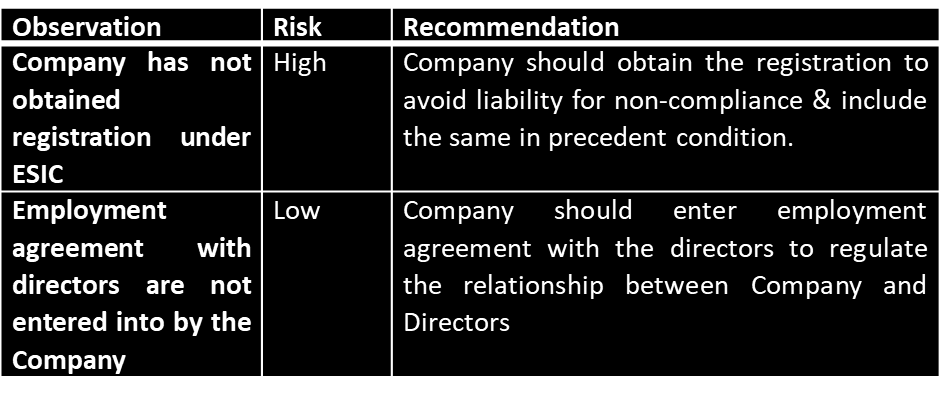What is Due Diligence & Need for Due Diligence
Due diligence is the investigation or exercise of care that is normally expected to take before entering into an agreement or contract with another party so as to ensure that all risks have been disclosed and all opportunities are on the table before the commercial deal proceeds.
While due diligence may seem like it only benefits one party, the fact is that due diligence helps both the buyer and the seller in a commercial deal.
From a buyer’s perspective, due diligence gives them peace of mind that they’re making the right deal and have all the information they need to make a good purchasing decision. .
From a seller’s perspective, due diligence helps a business owner take a deeper dive into the financial integrity of their business and can also help them uncover the fair market value of their company.
Commercial Due Diligence
Commercial due diligence is typically conducted before negotiations begin, in order to allow the potential buyer to assess the risks and potential of the target before entering in a commercial transaction deal. A Commercial Due Diligence report analyses company performance, the likelihood that the business will meet its targets, and highlights potential problems that may occur as a result of an acquisition & if the outcome of Commercial Due Diligence seems favourable & it is decided to have a commercial deal then a term sheet is agreed & Financial Due Diligence is initiated.
Financial Due Diligence
In this article, we would like to focus on Financial Due Diligence. Financial due diligence is a crucial assessment of the financial health of a business. The company’s historical and current financial performance is put under the microscope in order to establish future forecasts and identify any potential risks.

The aim is to determine whether the above points are true and accurate & helps the buy-side to get a better understanding of the company’s core performance metrics
Illustrative Points covered while conducting a Financial Due Diligence
(1) Business Overview-Details regarding the Promotors & Shareholding Pattern of the entity, its mission, initial subscribers to its MOA, BOD, Date of Incorporation etc
(2) Financial Overview-
-Items of Financial Statements-
- P & L items-
- Revenue: What contributes majorly to the revenue of the company i.e., recurring revenue & non-recurring revenue, key customers, comparability of revenue with previous years, accounting policy used for revenue recognition & segment wise analysis (customer wise, geographically, product wise etc)
- Cost of Goods Sold (COGS): Checking the Bill of Material (BOM) of the items, identifying the top suppliers who contribute substantially to Purchases in order to check about higher dependency on a particular supplier & if yes, looking for alternative suppliers to reduce dependency.
- Employee Cost: To check salary register & employee wise salary details. (Covered in detail in HR DD)
- EBITDA: Normalisation of EBITDA- When carrying out a DD, we tend to look for sales and expenses figures which are part of the normal day-to-day operations of the business, and we expect these activities to continue when the target has been acquired. So, any items included as sales or expenses to EBITDA but which do not constitute a normal and continued day-to-day part of the business’ normal operations have to be removed from EBITDA.
- Cash Flow Analysis: Trend over the past years in operating, investing & financing activities to be checked.
- Balance-sheet items-
- Receivables: Ageing, key target customers to be checked.
- Fixed Asset: Depreciation policy followed, Physical verification to be conducted and FAR to be checked.
- Inventory: Valuation method used, physical verification of inventory to be done.
- Borrowings: Details of Loan taken to be checked along with terms of repayment.
- Current Liabilities: Ageing for Trade Payables.
- Share Capital: The existing capital structure of the company to be
checked and any changes in the share capital structure expected in future.
- Compliances-
- Legal– To check whether there are any outstanding dues pending from any party, present contracts wherein future liability may arise.
- ROC– All ROC related compliances such as filing of Form DPT-3 (in case of loan from director), share certificates, MoM, etc are duly complied or not.
- Tax-To check Tax returns are duly filed at the appropriate due dates or not & if late payment is done, appropriate interest or penalty is paid. Any pending assessment or notices are received from the respective authorities and to determine its outcome in future also
4) HR Due Diligence– Details of Salaries & Wages, Director Remuneration and staff welfare expenses to be checked. Also, reconciliation of number of employees joined and resigned over the years and expected attrition in future to be checked. Check the HR policies in case of resignation of employees & future hiring plans of the company.
Observation Summary
Based on the Financial Due Diligence conducted, the observations along with risks & recommendations to be highlighted which is explained by way of an example as follows-

Conclusion
Post the current shift in the way of transacting, valuations and the multiple facets of the investment cycle are driven by diligence finds. An end-to-end diligence does not only throw light on the gaps and red flags, but also lends an expert eye into understanding nuances of the target better, thereby backing an informed decision-making process. With the above insights it is safe to conclude that due diligence in all its forms and scales makes for a key component of the transactional ecosystem.
In case you would like to have Due Diligence for your organization, contact us on the below-mentioned mail IDs.
CA Shreyans Dedhia
Partner, MASD
E-mail ID: shreyans.dedhia@masd.co.in
Poojan Joshi
Associate Consultant, MASD
E-mail ID: poojan.joshi@masd.co.in

